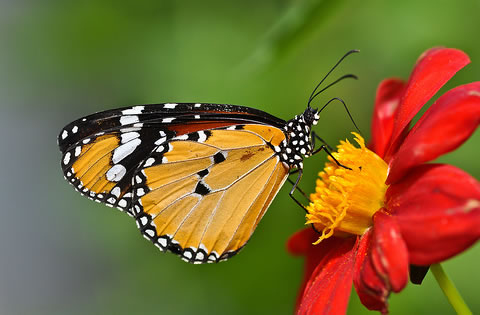The most common butterfly at the Cavern is the Garden Acraea. It is small, mostly dull orange with a few black spots, and with conspicuously transparent fore-wings. It flutters weakly around its favourite plant, Kiggelaria africana (Wild Peach tree). This is where it lays its eggs, so the caterpillars have the right food. Nearly every plant-eating insect specialises on the single species that it can digest (all plants produce defensive chemicals to keep the ravening hordes at bay). Acraea caterpillars are small, black and hairy, and are the main food of cuckoos. The caterpillars hatch in such numbers that they can eat every leaf on the tree. With no food left they must pupate. Now the tree grows a new set of leaves, recovering completely.

The African Monarch is also dull orange, but is bigger than the acraea, and does not have transparent fore-wings. It is fringed black, with big white spots on the wing tips, and is a strong flyer. It is not eaten by birds because it is poisonous. It gets its poison as a caterpillar, eating milkweeds such as Asclepias. The caterpillars are beautifully banded and spotted black, blue and yellow, obviously a warning to hungry birds.
Perhaps the beauty prize goes to the Green-banded Swallowtail. This is a dashing flyer, mainly black, with turquoise bands on the wings, and an extended “tail”. It frequents citrus plants, mostly wild relatives of the lemon, especially Calodendrum capense (Cape Chestnut) and Clausena anisata (Perdepis). Both these trees are common in the garden. The young caterpillars resemble bird droppings, a good way to avoid trouble. Older caterpillars adopt a different plan, becoming brightly coloured and capable of suddenly extruding a menacing-looking red structure from the head. This conveys a warning of worse to come, but it’s just a bluff that works.
David Johnson
